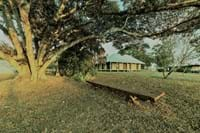HOW ‘STICKERS’ CAPTURED THE HEARTS OF THE TOUGH MINERS OF IPSWICH
21/11/2017
The Oxford English dictionary defines a collector as “a person who collects things of a specified type, professionally or as a hobby.”
One of the most unusual group of collectors were Queensland miners – especially coal miners in the Ipswich region. What they collected were stickers – stickers which came to serve multiple purposes.
They were luminous, very visible, therefore increasing safety underground when men stuck them onto their helmets; some were rare; some told stories of achievements, of milestones and openings, even disasters; many marketed the brand names of mining equipment from around the globe.
Today some of those stickers are rare and valuable; but, more importantly, they tell the story, in a very unique way, of a by-gone era.
The sticker ‘craze’ started around the late 1950s, when Joy Manufacturing, a leading supplier of heavy equipment to the mining industry, distributed adhesive and luminous stickers to promote their machinery.
They had no idea what they had started – half a century later many retired miners still cherish their carefully-maintained photo albums, full of stickers, or mount their valued stickers in ornate and expensive frames – and even boast how some of them make the best barramundi lures ever. Retired miner Col Webb swears that the silver ICI ‘Work safely with Explosives’ sticker was the best lure he ever used for barramundi.
Not long after Joy had distributed its stickers the competition were quick to follow – often at the request, insistence, of miners who caught on to what became something of a craze. These were hard men, men used to risking their lives every day they went underground, men not easily given over to sentimentality or emotion.
But hear the stories today and if there was ever one thing to raise envy in a hardened miner it was the sight of a colleague boasting on his hard hat a rare sticker, one maybe from Germany, Russia, Canada or some other distant mining centre.
Equipment company sales reps started making sure they had pocketfuls of stickers whenever they visited a site or ventured underground to inspect machinery.
“No other way of putting it, they were besieged for stickers,” recalls Col Webb, a veteran of the famous but tragic Box Flat mine in Ipswich.
Because stickers were so popular they moved out of the realm of ‘marketing’ for equipment suppliers and into the realm of chronicling history – mining companies started producing them to celebrate milestones.
They became a ‘collectors’ item.
For this article, Col Webb was proud to bring out his many photo albums, all filled with mining stickers covering nearly three decades.
He recalls the extent he went to to get stickers no-one else had, or would part with. Mine managers, for one, were often given the stickers first and would keep those they most prized, despite badgering from the men.
So Col Webb got himself a reference book of mining companies around the globe and wrote to them asking for stickers. Most sent him some – even when the languages were different. One unusual one was 3ft long – from the Timkens ball-bearing company. The Russians sent him stickers from their uranium mines and from Canada he received 20 stickers – works of art depicting the Orca whale, common in the oceans of Canada.
The Australian boss of the global giant Utah, based at Goonyella in the Bowen Basin, would not give him some of his prized Navaho stickers – so Col wrote to head office and received some not even the boss here had – one upmanship!
Ipswich’s Box Flat mine, now best known for the tragic disaster on July 31, 1972, closed when the access tunnel which exploded was sealed. Later, when the mine re-opened with a new tunnel, the first flexible conveyor train (FCT) in Australia, and only the second in the world, was installed in 1983. Box Flat then printed stickers commemorating that innovation.
Another milestone sticker commemorated 1,937 tons mined in one shift – a significant achievement.
If ever there was a ‘poster boy’ for collectors it’s Col Webb. He started at Box Flat in 1948 at age 15, working at the pithead on the surface. At age 16 he started underground, first as a ‘rope rider’ then, aged 18, on scraper loaders working with his father underground.
He spent 21 years working underground before gaining his open cut ticket. He was also in the world-renowned Mines Rescue team and a mines first aid instructor for nine years. He worked at Box Flat, Goonyella, the Aberdare No 8 shaft in Bundamba and at Southern Cross, working underground at Swanbank. He was working at the Norwich Park mine at Dysart when he retired on November 11, 1988.
But the memories remain strong – reinforced by occasionally paging through his treasured sticker albums.
Ian Muil



